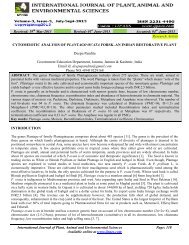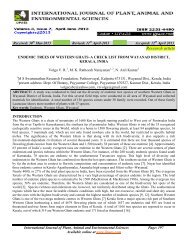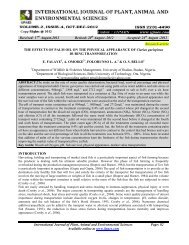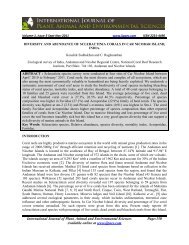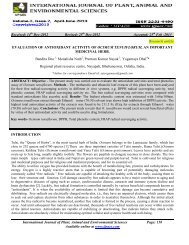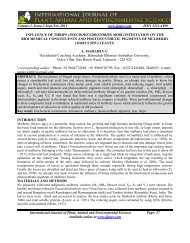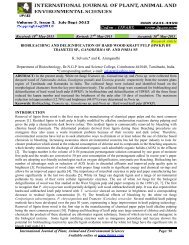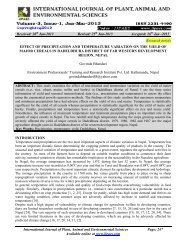distribution of arbuscular mycorrhizal fungi associated ... - Ijpaes.com
distribution of arbuscular mycorrhizal fungi associated ... - Ijpaes.com
distribution of arbuscular mycorrhizal fungi associated ... - Ijpaes.com
You also want an ePaper? Increase the reach of your titles
YUMPU automatically turns print PDFs into web optimized ePapers that Google loves.
Received: 01 st Dec-2012 Revised: 08 th Dec-2012 Accepted: 09 th Dec -2012Research articleDISTRIBUTION OF ARBUSCULAR MYCORRHIZAL FUNGI ASSOCIATED WITHLANDSCAPE TREE GROWTH IN INDIAN THAR DESERTMrs. Sonia Bohra* and Dr. Anil VyasDepartment <strong>of</strong> Botany, J.N.V.University, Jodhpur, Rajasthan, India.Email for correspondence: - soniamohanbohra@yahoo.inABSTRACT: Field and glasshouse pot studies were conducted to determine effects <strong>of</strong> urban expansion on<strong>arbuscular</strong> <strong>mycorrhizal</strong> fungal (AMF) populations and AMF impact on landscape tree growth. Soil and root segmentswere collected and evaluated for root colonization by AMF <strong>of</strong> trees at semi arid region sites and nearby, formerlydesert, drip-irrigated residential landscape sites in the Jodhpur, Rajasthan, India. Native desert trees had greatercolonization by AMF than residential landscape trees, and AMF species <strong>com</strong>position differed at the two site types. Aglasshouse pot experiment using AMF inocula from the desert or residential sites was used to evaluate AMF effectson growth <strong>of</strong> two landscape trees in pots relative to non-AMF controls. Growth and P nutrition <strong>of</strong> Acacia niloticaand Acacia senegal were increased by AMF colonization. We conclude that AMF might significantly increaselandscape tree carbon storage potential depending on tree species, AMF population characteristics, soil wateravailability, and improved P uptake.Key Words: Urban forest; Mycorrhizae; Acacia senegal; Acacia nilotica, Glomus fasciculatum, Thar Desert,Landscape trees.INTRODUCTIONTrees are important <strong>com</strong>ponents <strong>of</strong> landscapes whether that is in urban or rural landscapes. Their importanceincludes their economic, biodiversity, conservation, ecological, aesthetic and spiritual value. Woodlands and forestsinclude stabilization <strong>of</strong> soil through their root system, absorption <strong>of</strong> CO2 and the cooling effects <strong>of</strong> canopies <strong>of</strong> trees.Arbuscular <strong>mycorrhizal</strong> <strong>fungi</strong> (AMF) are obligatory endophytes that form symbiotic associations with approximately90% <strong>of</strong> all higher plants. Past research has shown that AMF affect host plant growth, P uptake, water status, andresistance to biotic and abiotic stresses. AMF might extract an estimated 5% to 20% <strong>of</strong> labile photosynthates fromcolonized plant roots. AMF have been shown to differentially colonize plant roots, causing a variety <strong>of</strong> effects onplant growth, biomass allocation, and photosynthesis. Presently, it is unknown to what extent urban expansion mightimpact AMF population characteristics and AMF effects on landscape tree carbon sink potential. Preliminaryevaluation <strong>of</strong> AMF populations along a time since-development gradient from arid zone’s urban core to the city’sedge showed that recently developed areas (less than 5 years) had less species diversity than landscapes developed20 to 40 years ago [7].Cities such as jodhpur are places <strong>of</strong> elevated atmospheric CO 2. Because AMF have beenshown to stimulate belowground carbon sink strength under conditions <strong>of</strong> elevated CO 2 [3], the potential might existfor AMF to increase the carbon sink potential <strong>of</strong> managed urban landscape trees. One objective <strong>of</strong> this research wasto investigate how land-use change <strong>associated</strong> with urban expansion affects AMF population and colonizationcharacteristics by <strong>com</strong>paring patterns <strong>of</strong> root colonization <strong>of</strong> native trees at Thar Desert sites to those <strong>of</strong> landscapetrees at nearby, recently developed residential sites. Another objective was to determine if there are differences in theability <strong>of</strong> AMF populations from desert or residential sites to affect landscape tree growth.International Journal <strong>of</strong> Plant, Animal and Environmental Sciences Page: 98Available online at www.ijpaes.<strong>com</strong>
Sonia Bohra and Anil Vyas Copyrights@2013 IJPAES ISSN 2231-4490Our results support the previous observations about frequent occurrence <strong>of</strong> Gigaspora and Glomus in differentregions <strong>of</strong> Indian Thar Desert [5]. Though AM fungal species were not found to be effected by host specificity for its<strong>distribution</strong> in this region however, some species were found to be more abundant in its occurrence as <strong>com</strong>pare withthe others. In the desert inoculum, Glomus deserticola <strong>com</strong>prised approximately 50% <strong>of</strong> the spores present, andAcaulospora morrowae <strong>com</strong>prised approximately 35%.In the residential inoculum, G. fasciculatum <strong>com</strong>prisedapproximately 40% <strong>of</strong> the spores present, and Sclerocystis rubiformis <strong>com</strong>prised approximately 40%. A volume <strong>of</strong>inoculum was added to three germinated seedlings per pot for Acacia. One week after germination, Acacia seedlingswere thinned to one per pot. Inoculum was added sub radically during potting into each container. All non-AMFcontrol trees received a 150-ml <strong>of</strong> mixed inoculum filtrate to establish similar soil micro biota as trees treated withAMF inoculum. All trees were then grown for 5 months in an environmentally controlled glasshouse where averageday/night temperature 30/25°C and relative humidity between 55% and 65% during the day. Samples were analyzedmicrobiologically and chemically for the determination <strong>of</strong> Total shoot length were measured on 1 and 153 days afterpotting. Samples <strong>of</strong> root material from all plants were stained as described above and evaluated for AMFcolonization. Shoots and roots were separated and dried in a drying oven at 60°C (140oF) for 72 hr and dry weightsrecorded. Pulverized leaf tissue samples were analyzed for P concentration by the ascorbic method (Wantabe andOlson 1965). For both field and glasshouse pot studies, all statistical <strong>com</strong>parisons were made by ANOVA. The level<strong>of</strong> significance was set at α = 0.05 Results.RESULTSField Study: Roots <strong>of</strong> native trees at the Desert sites were colonized by AMF to a greater extent than were landscapetree roots at the nearby residential sites because <strong>of</strong> greater root colonization with hyphae (Figure 1). Roots <strong>of</strong>residential trees were also colonized by septate, non<strong>mycorrhizal</strong> <strong>fungi</strong>, which were not found on roots <strong>of</strong> desert trees.Eighteen species <strong>of</strong> five genera <strong>of</strong> AM <strong>fungi</strong> were detected in trap cultures from residential and desert samplingsites (Table 1). None <strong>of</strong> the AMF species occurred at all the sampling sites. AMF species richness at each samplingsite ranged from five to seven species at the residential sites and four to five species at the desert sites. Fifteen <strong>of</strong> theeighteen detected AMF species occurred at both residential and desert sites. Three AMF species, G. aggregatum,Sclerocystis rubiformis and Scutellospora nigra occurred only at residential sites, and two species, A. morrowae andGigaspora margarita was only detected at one <strong>of</strong> the desert sites.Table 1. Arbuscular <strong>mycorrhizal</strong> fungal (AMF) species detected in trap cultures from residential and Desertsites in western Rajasthan area.S.No. AMF Species Desert Sites Residential Sites1 Acaulospora morrowae _ +2 A. laevis + +3 A. mellea + +4 A .sporocarpia + +5 Gigaspora margarita _ +6 Glomus deserticola + +7 G. fasciculatum + +8 G. mosseae + +9 G. geosporum + +10 G. macrocarpum + +11 G. aggregatum + _12 Sclerocystis rubiformis + _13 S. corieomoides + +14 S. microcarpus + +15 Scutellospora callospora + +16 S. nigra + _17 S. heterogama + +18 S. aurigloba + +International Journal <strong>of</strong> Plant, Animal and Environmental Sciences Page: 100Available online at www.ijpaes.<strong>com</strong>
Sonia Bohra and Anil Vyas Copyrights@2013 IJPAES ISSN 2231-4490Figure 1. Percentage <strong>of</strong> root colonization <strong>of</strong> Acacia in response to <strong>arbuscular</strong> <strong>mycorrhizal</strong> fungal (AMF)inoculum derived from under canopy rhizosphere <strong>of</strong> trees at Desert or nearby residential sites in westernRajasthan area.Glasshouse Pot Study: Roots <strong>of</strong> all trees inoculated with the non-AMF control drench remained non<strong>mycorrhizal</strong>.Both Desert and residential AMF populations colonized roots <strong>of</strong> trees differently (Figure 1). Roots <strong>of</strong> Acaciainoculated with either the desert or residential AMF population treatments were strongly <strong>mycorrhizal</strong>. The residentialAMF treatment elicited a 60% increase in P uptake by Acacia <strong>com</strong>pared with the non <strong>mycorrhizal</strong> control treatment(Table2). In general, AMF differentially affected growth <strong>of</strong> the two landscape trees i.e., A.nilotica and A.senegal(Table 2). For Acacia, AMF from the desert sites increased tree total shoot length (SL), total dry weight (TDW),shoot dry weight (SDW), root dry weight (RDW), and shoot to root ratio (SR) <strong>com</strong>pared with AMF speciesResidential Desert.AMF from the residential sites increased Acacia growth variables except for TDW, SDW, and RDW, which weresimilar to those <strong>of</strong> the non-AMF controls. Desert and residential AMF populations increased carbon assimilation (A)by Acacia leaves by about 80% <strong>com</strong>pared with the non-AMF control treatment.DISCUSSIONPrevious research has shown that soil disturbance substantially lowers AMF diversity (Giovannetti and Gianinazzi-Pearson 1994). The process <strong>of</strong> urbanization and in particular the change from a relatively natural, undisturbed deserthabitat into suburban <strong>com</strong>munities <strong>of</strong> medium-density single family homes with intensively managed landscapestypically begins with disturbance <strong>of</strong> the rhizosphere pr<strong>of</strong>ile. Therefore, we may assume that the initial disturbances<strong>associated</strong> with the transition <strong>of</strong> our residential sites from their original undisturbed desert habitat into a residentialland use had an adverse effect on the residing native AMF population structure (Roldan et al. 1997). Our datashowed that after disturbance and landscape installation, the association <strong>of</strong> AMF species found in soil at theresidential sites was different from that <strong>of</strong> nearby remnant desert habitats and this difference was ac<strong>com</strong>panied byless root colonization with hyphae. Re-establishment <strong>of</strong> AMF populations at the residential sites after initialdisturbance and landscape installation may be dependent on three factors: the mode <strong>of</strong> AMF dispersal, the timeelapsed since disturbance (Jasper et al. 1991), and the biophysical environment at these intensively managedresidential landscapes. At present, we know <strong>of</strong> no studies examining modes <strong>of</strong> AMF dispersal into urban areas,though we speculate that such modes might include wind dispersal, the local and regional transport <strong>of</strong> <strong>mycorrhizal</strong>nursery stock to landscape transplant sites, and/ or movement <strong>of</strong> AMF spores and assemblages by humans. Also,cultural practices such as watering and fertilization, the root characteristics <strong>of</strong> the host plant and host–fungus<strong>com</strong>patibility, and edaphic conditions such as pH, nutrient levels, moisture, salinity, and temperature can have asubstantial effect on AMF population characteristics (Brundrett 1991).International Journal <strong>of</strong> Plant, Animal and Environmental Sciences Page: 101Available online at www.ijpaes.<strong>com</strong>
Sonia Bohra and Anil Vyas Copyrights@2013 IJPAES ISSN 2231-4490Although AMF are generally thought to have little host specificity, there may be a certain degree <strong>of</strong> plant/endophyte<strong>com</strong>patibility, and some plants may even resist AMF colonization (Brundrett 1991). In the present study, we foundthat growth, carbon assimilation, and P nutrition <strong>of</strong> two regionally <strong>com</strong>mon landscape trees in response to AMFpopulation from residential or desert sites were different. AMF colonization elicited increased growth and P uptakefor both Acacia species. . For Acacia, shoot and root growth enhancement which gives clear evidence <strong>of</strong> an increasein photosynthate production coincident <strong>of</strong> the AMF association. These effects were more pronounced for Acaciatrees inoculated with AMF from the desert site than the residential site.CONCLUSIONOur data suggest that urbanization can alter the <strong>com</strong>position <strong>of</strong> AMF populations and that modification <strong>of</strong> the soilenvironment, particularly the practice <strong>of</strong> landscape irrigation, might reduce AMF colonization <strong>of</strong> some tree roots.Our data also suggest that AMF can increase tree carbon storage potential in the urban areas, although this capacityin managed residential landscapes might be somewhat less than in nearby undisturbed soils because <strong>of</strong> a highercarbon cost to benefit ratio. Ultimately, the ability <strong>of</strong> AMF to increase landscape tree growth is likely a function <strong>of</strong>tree species and factors such as water availability and enhanced P uptake.ACKNOWLEDGMENTSS.B thanks Dr. Anil Vyas and J.N.V University for conducting the research and providing facilities in the department<strong>of</strong> botany.REFERENCES[1] Tewari, V.P., Singh, M., 2006. Tree-crop interaction in the Thar Desert <strong>of</strong> Rajasthan (India). SECHERESSE.,17, 1-7.[2] Abbott, L.K., and C. Gazey. 1994. An ecological view <strong>of</strong> the formation <strong>of</strong> VA mycorrhizas. Plant Soil 159:69–78.[3] Berntson, G.M,. P.M. Wayne, and F.A. Bazzaz. 1997. Below-ground architectural and <strong>mycorrhizal</strong> responsesto elevated CO2 in Betula alleghaniensis populations. Function. Ecol.11:684–695. Brundrett, M. 1991.Mycohrrhizas in natural ecosystems.[4] Bohra Sonia and Vyas Anil, 2012. Effect <strong>of</strong> AM <strong>fungi</strong> on Biomass production and Nutrient uptake <strong>of</strong>Agr<strong>of</strong>orestry tree seedling <strong>of</strong> Acacia species. STM Journal, RRJB, Vol.1, Issue 2, 22-28. ISSN: 2278-2222[5] Mathur Nishi and Vyas Anil, 1996. Biochemical changes in Ziziphus xylopyrus by VA mycorrhizae. Bot. Bull.Acad. Sin.209-2012.[6] Linda B. Stabler et al., 2001. Effect <strong>of</strong> urban expansion on <strong>arbuscular</strong> <strong>mycorrhizal</strong> fungal mediation <strong>of</strong>landscape tree growth. Journal <strong>of</strong> Arboriculture 27(4).[7] Stutz, J.C., and C.A. Martin. 1998. Arbuscular <strong>mycorrhizal</strong> fungal diversity <strong>associated</strong> with ash trees in urbanlandscapes in Arizona. Phytopathology.88:86.[8] Jeffries P, Barea JM 2001. Arbuscular mycorrhiza: a key <strong>com</strong>ponent <strong>of</strong> sustainable plant-soil ecosystem. In:Hock B (ed) The Mycota IX: fungal associations Springer. Berlin Heidelberg. New York, pp 95-113International Journal <strong>of</strong> Plant, Animal and Environmental Sciences Page: 102Available online at www.ijpaes.<strong>com</strong>



